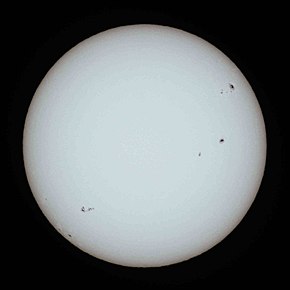Atmosphere of the Sun

|
|
| Observation data | |
|---|---|
| Mean distance from Earth |
1 au ≈ 1.496×108 km 8 min 19 s at light speed |
| Visual brightness (V) | −26.74 |
| Absolute magnitude | 4.83 |
| Spectral classification | G2V |
| Metallicity | Z = 0.0122 |
| Angular size | 31.6–32.7 minutes of arc |
| Adjectives | Solar |
| Orbital characteristics | |
| Mean distance from Milky Way core |
≈ 2.7×1017 km 27,200 light-years |
| Galactic period | (2.25–2.50)×108yr |
| Velocity | ≈ 220 km/s (orbit around the center of the Milky Way) ≈ 20 km/s (relative to average velocity of other stars in stellar neighborhood) ≈ 370 km/s (relative to the cosmic microwave background) |
| Physical characteristics | |
| Equatorial radius |
695,700 km 109 × Earth |
| Equatorial circumference |
4.379×106 km 109 × Earth |
| Flattening | 9×10−6 |
| Surface area |
6.09×1012 km2 12,000 × Earth |
| Volume |
1.41×1018 km3 1,300,000 × Earth |
| Mass |
(1.98855±0.00025)×1030 kg 333,000 × Earth |
| Average density |
1.408 g/cm3 0.255 × Earth |
| Center density (modeled) |
162.2 g/cm3 12.4 × Earth |
| Equatorial surface gravity |
274.0 m/s2 27.94 g 27,542.29 cgs 28 × Earth |
| Moment of inertia factor | 0.070 (estimate) |
|
Escape velocity (from the surface) |
617.7 km/s 55 × Earth |
| Temperature | Center (modeled): 1.57×107 K Photosphere (effective): 5,772 K Corona: ≈ 5×106 K |
| Luminosity (Lsol) |
3.828×1026 W ≈ 3.75×1028 lm ≈ 98 lm/W efficacy |
| Mean radiance (Isol) | 2.009×107 W·m−2·sr−1 |
| Age | ≈ 4.6 billion years |
| Rotation characteristics | |
| Obliquity | 7.25° (to the ecliptic) 67.23° (to the galactic plane) |
|
Right ascension of North pole |
286.13° 19 h 4 min 30 s |
|
Declination of North pole |
+63.87° 63° 52' North |
| Sidereal rotation period (at equator) |
25.05 d |
| (at 16° latitude) | 25.38 d 25 d 9 h 7 min 12 s |
| (at poles) | 34.4 d |
| Rotation velocity (at equator) |
7.189×103 km/h |
| Photospheric composition (by mass) | |
| Hydrogen | 73.46% |
| Helium | 24.85% |
| Oxygen | 0.77% |
| Carbon | 0.29% |
| Iron | 0.16% |
| Neon | 0.12% |
| Nitrogen | 0.09% |
| Silicon | 0.07% |
| Magnesium | 0.05% |
| Sulfur | 0.04% |
The Sun is the star at the center of the Solar System. It is a nearly perfect sphere of hot plasma, with internal convective motion that generates a magnetic field via a dynamo process. It is by far the most important source of energy for life on Earth. Its diameter is about 109 times that of Earth, and its mass is about 330,000 times that of Earth, accounting for about 99.86% of the total mass of the Solar System. About three quarters of the Sun's mass consists of hydrogen (~73%); the rest is mostly helium (~25%), with much smaller quantities of heavier elements, including oxygen, carbon, neon, and iron.
The Sun is a G-type main-sequence star (G2V) based on its spectral class, and is informally referred to as a yellow dwarf. It formed approximately 4.6 billion years ago from the gravitational collapse of matter within a region of a large molecular cloud. Most of this matter gathered in the center, whereas the rest flattened into an orbiting disk that became the Solar System. The central mass became so hot and dense that it eventually initiated nuclear fusion in its core. It is thought that almost all stars form by this process.
The Sun is roughly middle-aged; it has not changed dramatically for more than four billion years, and will remain fairly stable for more than another five billion years. After hydrogen fusion in its core has diminished to the point at which it is no longer in hydrostatic equilibrium, the core of the Sun will experience a marked increase in density and temperature while its outer layers expand to eventually become a red giant. It is calculated that the Sun will become sufficiently large enough to engulf the current orbits of Mercury, Venus, and probably Earth.
...
Wikipedia
